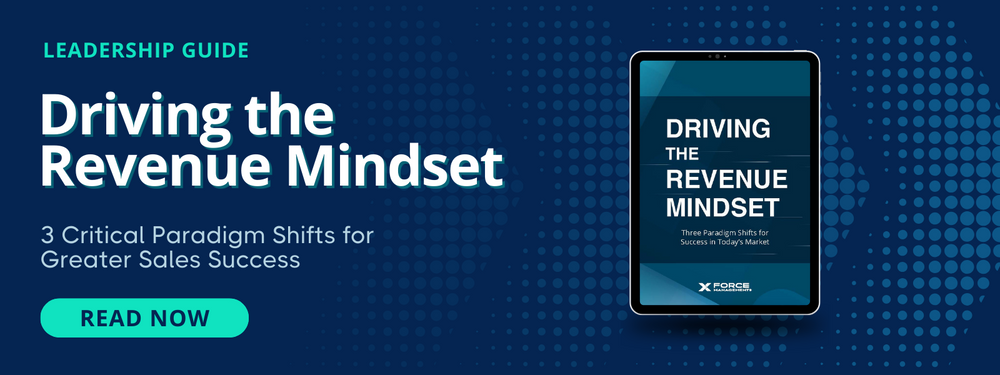
How to Prevent Slipped Deals at the End of the Quarter
Categories: Sales Messaging | Sales Transformation | Company Alignment | MEDDICC
When one deal slips, that’s a deal problem. Nobody likes a missed opportunity, though sales professionals accept that some slippage comes with the territory. But when slipped deals are a consistent end-of-quarter occurrence, that’s an organizational problem with serious negative consequences. Companies that can’t rely on forecasts feel ripple effects across the organization, impacting product, delivery, operations, and finance. Unreliable revenue means falling shortof the expectations of your board and leadership.
Frequent deal slippage indicates a broader issue with your qualification and sales execution process. It signals that reps aren’t qualifying deals appropriately and managers aren’t coaching effectively. Leaders of revenue teams with a high slip rate need a systematic fix for an organizational challenge.
On the Revenue Builders Podcast, hosts John Kaplan and John McMahon met with featured guest John Donnelly III, CRO with DTiQ and Co-Founder of e2log, to break down the reasons why deals slip, and the strategies leaders can use to solve the problem.
Top Three Reasons Why Deals Slip
1. Not attaching to the biggest business issue
How this problem shows up: “There’s just not a lot in the budget.”
We know budget limitations are real, but repeatedly hearing this objection indicates that revenue teams are having sales conversations rather than business conversations. They aren’t instilling value by conveying the business problems they solve for the customer.
There’s an old rule of thumb that says, “You get delegated to who you sound like.” If your GTM team is stressing features and functions, they’ll likely be directed to the people who think about features and functions. When your team describes their solution by communicating the business problems they solve, they are speaking the language of influence and are more likely to get meetings with Economic Buyers and C-level decision makers.
Help your teams rise above the noise of a competitive marketplace with a message that resonates with the customer’s top brass. Overcome the budget objection with a focused messaging framework that creates customer value from the first interaction. Build a coaching cadence that helps revenue teams structure sales conversations in ways that focus on value and align their differentiation with what is important to the buyers. The shift to business conversations will open doorways for repeated access to key decision-makers who almost always have the budget to solve pressing business problems.
2. Didn’t do a reverse timeline with the Champion
How this problem shows up: “Someone came along, stalled the process, and won’t sign off.”
When deals don’t close because of surprises in the client’s buying process, it signals holes in your team’s qualification approach. Adopting an effective qualification system ensures buyers and sellers are aligned throughout the process, with executive buy-in integrated along the way. The gold-standard qualification method for revenue teams selling B2B SaaS and Tech solutions is MEDDICC.
Teams that execute MEDDICC consistently aren’t caught off-guard by steps in the Decision Process. Their Champion has provided access to the Economic Buyer, who agrees that the solution meets their Decision Criteria.
In this clip from the Revenue Builders Podcast, John Kaplan outlines how building a reverse timeline with the Champion helps uncover unknown people or steps in the customer’s buying process.
When a deal doesn’t land, some leaders diagnose the issue by asking, “Did you get to the Economic Buyer?” If the answer is no, they can trace through the unanswered or incomplete data points in MEDDICC. If they didn’t get to the Economic Buyer, they never had a true Champion. If there’s no Champion, that points to a lack of deep discovery to identify the business pain or uncover who’s who within the buyer landscape. Everything has to go right to reach the Economic Buyer. If that conversation never happened, the reasons why are in the acronym.
Check out our MEDDICC Resource Library for eBooks, videos, and tools to help install a systematic approach to qualifying that will yield more reliable forecasts and less end-of-quarter surprises.
3. Didn’t do enough to differentiate yourself
How this problem shows up: “They decided to go with a competitor.”
Losing out to the competition means the decision criteria were not influenced in your favor. When it happens repeatedly, it indicates a weakness in your sales messaging. Your team did not articulate differentiation in ways that align with the buyer’s top priorities.
Help your teams identify the problem before it happens by coaching them on testing Champions. Remember, a true Champion is three things: they have power and influence, they actively sell on your behalf, and they have a vested interest in your success. In this video, John Kaplan outlines a strategy managers can use to show reps how to test Champions, and how to flip an opportunity that’s at risk by strengthening the Champion’s buy-in and advocacy:
Solve the Slipped Deal Problem
Change the end-of-quarter narrative; set the stage for success by minimizing slipped deals and aligning how revenue teams qualify new deals and renewals. Build a customer-centered messaging framework that conveys your value and differentiation through business-level conversations. Empower managers with the tools and training they need to be effective front-line coaches. Ensure consistency of application across teams with a clear picture of what good looks like.
Drive Alignment with an Organizational Revenue Mindset
Deals and renewals aren’t won or lost at one entry point. Your GTM organization has several customer-facing groups: Customer Success, Inside Sales, BDRs, Account Managers, etc. You need an approach that ensures consistent sales execution throughout customer engagement and across customer-facing teams. We call this dynamic an organizational revenue mindset.
Our ebook, Driving the Revenue Mindset, covers how leaders can align their teams to execute effectively and consistently on the revenue strategy. If you're feeling the pressure to help your teams achieve aggressive growth goals, these strategies can help you put that plan into action. Check it out.



